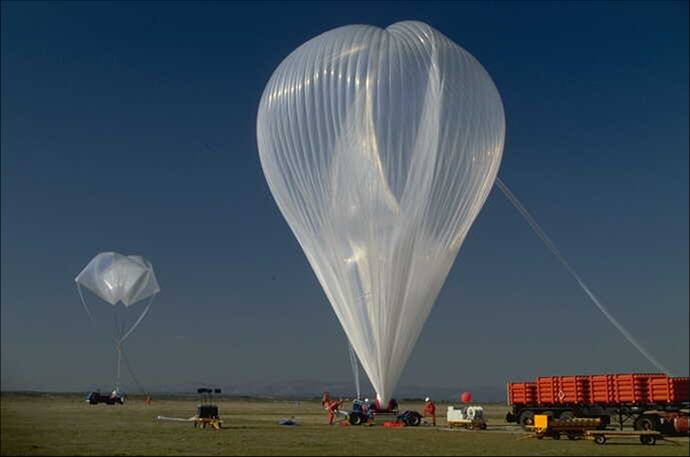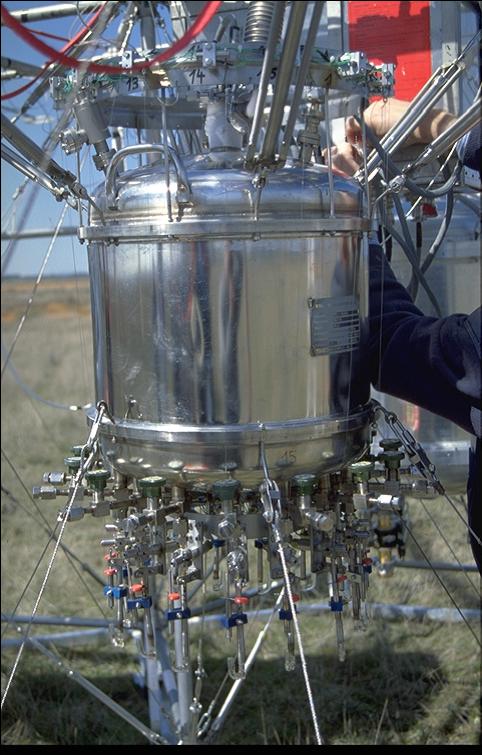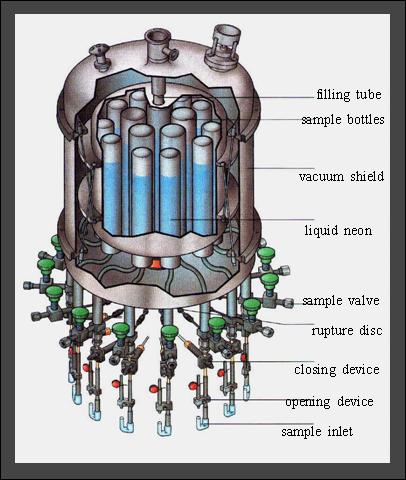Cryogenic Air Sampler
For the measurement of stratospheric trace gases, the institute uses three different balloon-mounted cryogenic air samplers. The measurements are conducted to study stratospheric trace gas budgets and their temporal development, as well as to investigate stratospheric transport. Measurements with these collectors have been carried out since 1982 creating a long-term, consistent data series. The samples are measured at the Institute for Atmospheric and Environmental Sciences (Goethe University Frankfurt), the Institute for Environmental Physics (University of Heidelberg), the University of East Anglia in Norwich (England) and the Institute for Marine and Atmospheric Research Utrecht (IMAU) (University of Utrecht), which are cooperation partners of the institute.
 |
| Figure 1: Balloon Start |
Air collection is carried out according to the principle of whole air sampling, wherein the collectors are cooled down to 27K using liquid neon. The inflowing air freezes on the inside of the sample containers. After thawing of the samples, an overpressure of up to 70 bar builds up inside of the containers. In cooperation with the French space agency CNES (Centre National d'Études Spatiales), the air samplers are flown at heights of up to 40 km with the help of stratospheric balloons.
 |
| Figure 2: Air Sampler BONBON |
Two collectors were developed at the research center of Jülich between 1980 and 1985. These two collectors (BONBON) each have 15 sample containers with volumes of 580 or 350 ml. In 2006, a lighter collector called CLAIRE (Cryogenic Lightweight AIR Sampling Experiment) with 26 sample containers (volume of 140ml per container) was developed at the University of Frankfurt. Both collector types have internally electropolished stainless steel containers in order to achieve a passive inner surface and a good sample stability. The inlets consist of a thin-walled gold tube closed with a glass cap. The sample containers are opened by triggering a spring pin, which deflects the glass cap. The sample containers are closed by crushing the glass tube (cold welding) with the aid of an electrically ignited detonator. As a result, on the one hand a high flow rate can be achieved, on the other hand, any kind of plastic gaskets can be avoided, which prevents sample contamination. Due to this high flow rate, a low collection time, which equals a high time resolution (a few minutes), is achieved even at low external pressures.
 |
| Figure 3: schematic representation of BONBON |
The inlets of the BONBON collectors (designed for air sampling in descent) point downwards, which allows a clean inflow while the balloon descends. The lightweight construction of the cryogenic air sampler CLAIRE is designed for air sampling in the ascent. A reduction in weight is achieved by using other dewarm materials (glass fiber reinforced plastic) and less liquid neon. The inlets point upwards, so samples are collected in the ascent. CLAIRE only weighs 100kg including gondola and can therefore also be used on smaller balloons.
 |
| Figure 4: CLAIRE during a balloon flight |




 deutsche Version
deutsche Version